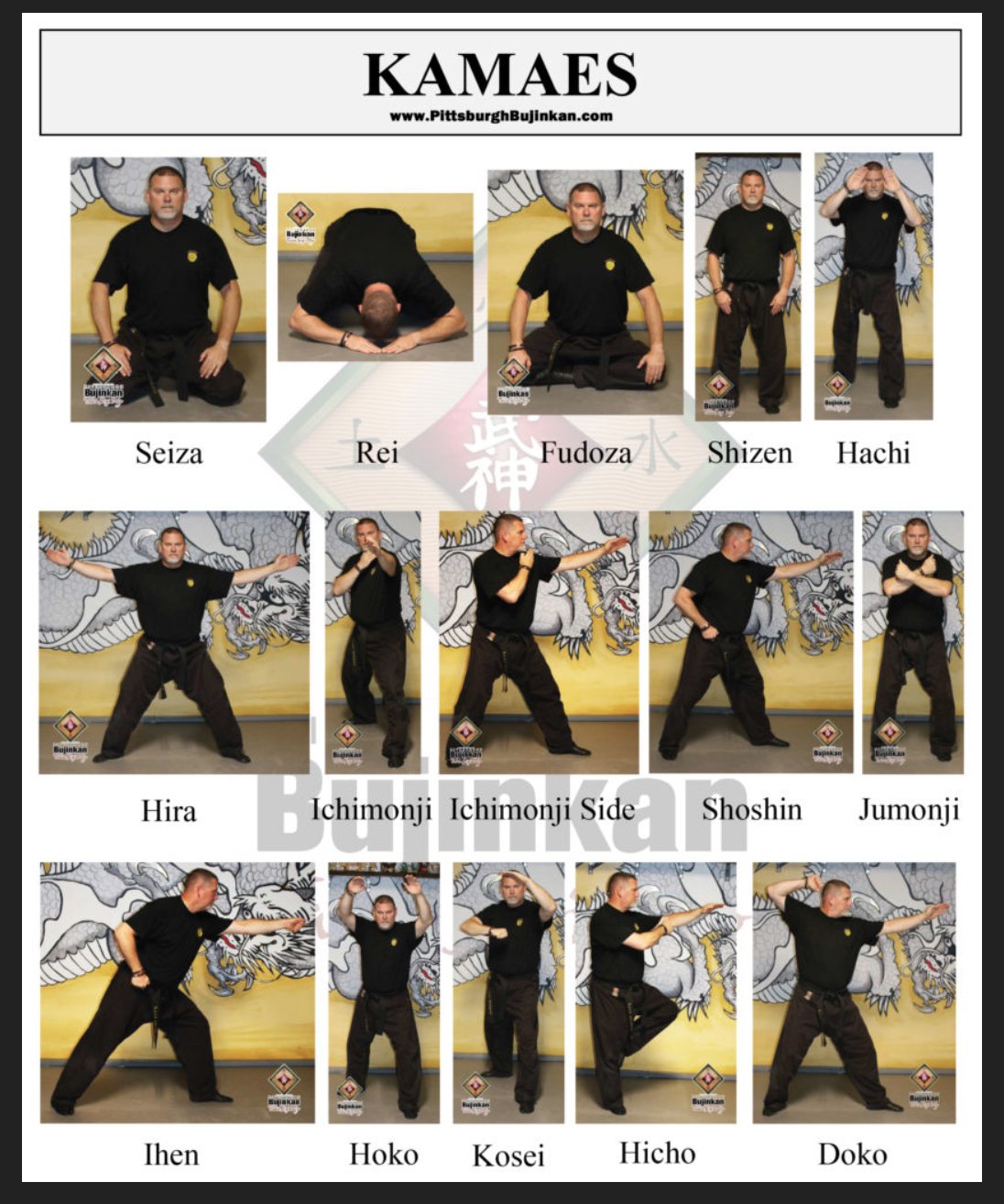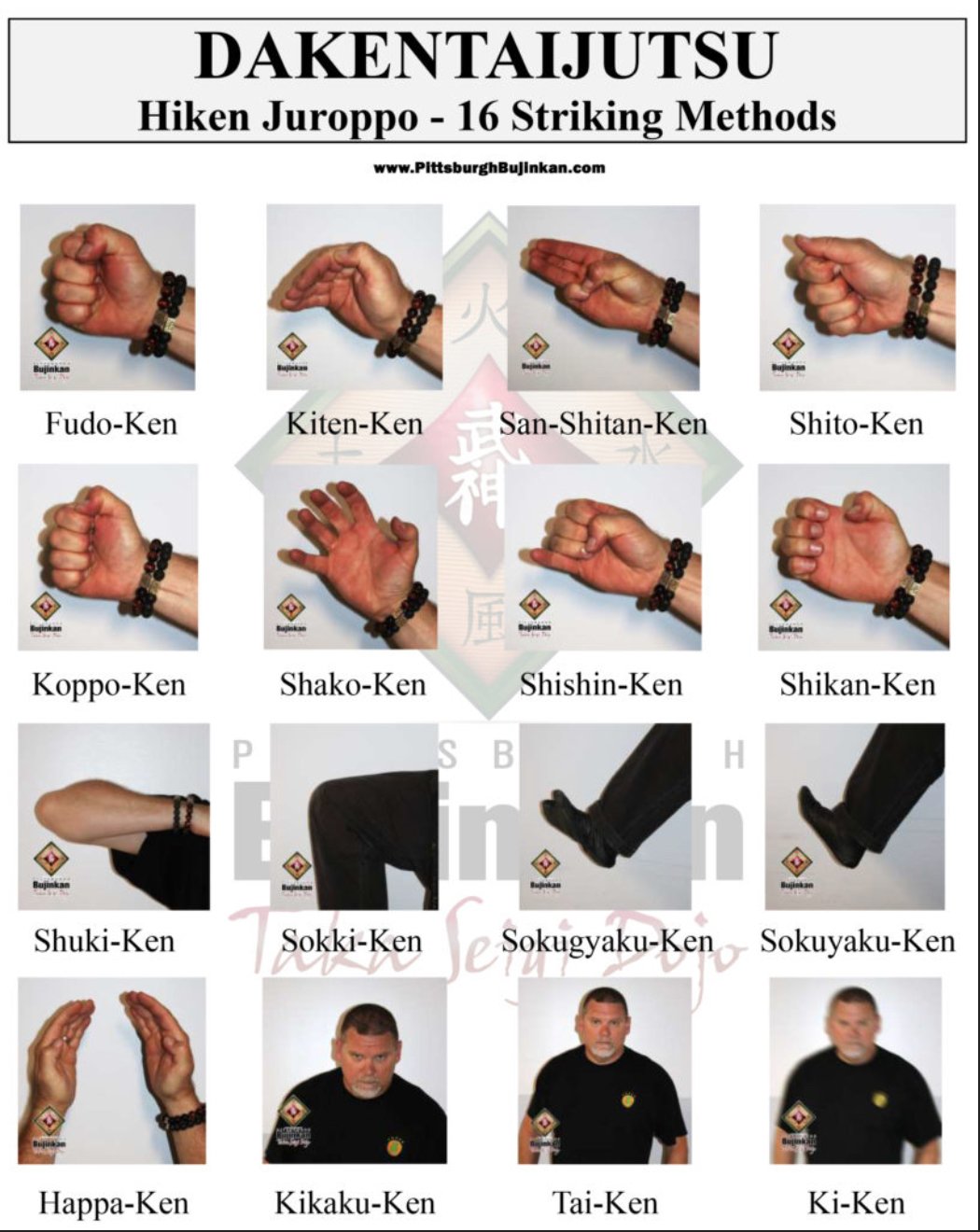
Student Resources
Saku Bujinkan Dojo Rules:
Bring proper attitude
Impeccable hygiene
Full gi and belt
Be early to class
Help set up/break down
Payment by 1st of the month
No complaining even if you die
Remember, it’s a gift!
No talking while Sensei is talking
Represent Saku Bujinkan outside class with integrity
Ask questions yet consider Sensei’s word as final
Bow In:
Shiken harimitsu daikoumyo
“At any moment, the potential for enlightenment is possible; to seek a bright future of enlightenment by loving, being true and natural and persevering with dedication.”
When we bow in and out of class, we hold the thought of ‘From every experience, I shall gain my greatest good.’ In other words, regardless of whether or not the experience was “good” or “bad,” I will still learn something from it.
Onegaishimasu
“Please assist me.” A form of respect and honor toward your teacher and senior.
Bow Out:
Domo arigato gozaimashita
“Thank you very much”
Basic Kamaes
Shizen | Seiza | Fudoza | Rei | Hachi | Hira | Hoko | Jumonji
Ichimonji | Ichimonji Ihen | Hicho | Doko | Bobi | Shoshin
Kosei | Segan | Hanza | Kongo Gassho
Basic Fists & Strikes (Dakentaijutsu)
Fudo-Ken | Kaiten-Ken | San-Shitan-Ken | Shito-Ken | Boshi-Ken
Koppo-Ken | Shako-Ken | Shishin-Ken | Shikan-Ken
Happa-Ken | Ura & Omote Shuto
Sokugyaku-Ken | Sokuyaku-Ken
Shuki-Ken | Sokki-Ken
Sanshin no Kata
The Sanshin no Kata is made up of five exercises, named after the elements.
Chi no Kata (earth)
Sui no Kata (water)
Ka no Kata (fire)
Fu no Kata (wind)
Ku no Kata (void)
The Kihon Happo (基本八法), together with the Sanshin No Kata, are the foundation for Bujinkan Budo Taijutsu. Taken from Gyokko-ryu, they are pretty much the alphabet of our taijutsu.
The Kihon Happo
The name literally means “basic eight ways”, and the techniques come from Gyokko Ryu (玉虎流), the oldest ryu-ha in the Bujinkan. The techniques are:
A) Koshi Kihon Sanpo (striking)
1) Ichimonji no Kamae 一文字の構,
2) Jumonji no Kamae十文字の構
3) Hicho no Kamae 飛鳥の構
B) Torite Kihon Goho (grappling)
4) Omote Gyaku 表逆
5) Omote Gyaku Tsuki
6) Ura Gyaku 裏逆
7) Musha Dori 武者捕
8) Ganseki Nage 巌石投
(Bonus)
Oni kudaki 鬼砕 (demon crusher)
Ura oni kudaki
**Some instructors leave out Oni Kudaki and have Omote Gyaku Tsuki instead, which is basically an Omote Gyaku done against a grab-and-punch attack**
Counting 1-10
Ichi (2) Ni - (3) San - (4) Yon - (5) Go
(6) Roku - (7) Nana - (8) Hachi
(9) Kyuu- (10) Juu
Ukemi (to receive)
Forward roll, side roll, back roll, yoko nagare, kart wheel, handsprings
Zenpo ukemi - Breakfalls
Koho Kaiten - Backroll
Kuten - Handspring
-
Yame - stop
Hai - yes or understood
Uke & Tore - attacker and recipient
Taijutsu - unarmed body movement
Waza - technique
Kata - forms; choreography
Kamae - postures/poses
Kami hitoi - as close/thin as a sheet of paper
Ihen - forward lean
Uke nagashi - receiving in the flow
Totoku - shield
Henka - variation
Jupo sesho - being in the future
Kuzushi - off balancing
Metsubishi - deceptive distraction
Muto dori - make them think they’re winning until they’re not
Tai sabaki - body movement/evasion
Ashi sabaki - leg/foot movement/evasion
Zanshin - awareness
Kukan - the space between us
-
Dakentaijutsu - striking techniques
Jodan - upper receive/block
Chudan - mid receive/block
Gedan - lower receive/block
Tsuki - thrust/punch
Keri - kick
Nage - throws
Kihon Happo - eight basic ways
Koshi Kihon Sanpo - The Three Basic Ways of Striking
Torite Goho Gata - The Five Forms of Grappling
San Shin No Kata - The Three Hearts Forms
Hajutso Kuho - The Eight Techniques & Nine Ways
Tehodoki - Wrist Escapes
Taihodoki - Body Escapes
Gyaku Waza - Reversal Techniques
Nage Waza - Throwing Techniques
Jime Waze - Choking Techniques
-
Yari - spear
Bo - long staff
Hanbo - short staff
Bokken - wooden practice sword
Shinai - bamboo practice sword
Katana - metal sword
Tanto - dagger
Kusari Fundo - weighted chain weapon
Shuriken - throwing star
Yumi - bow



